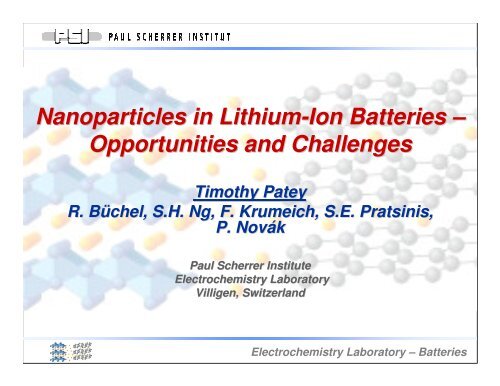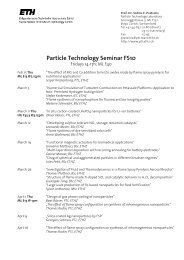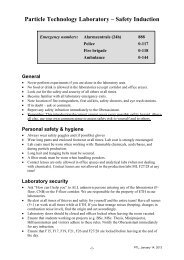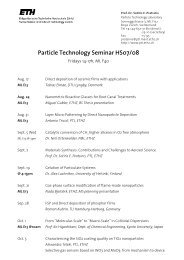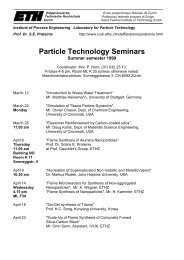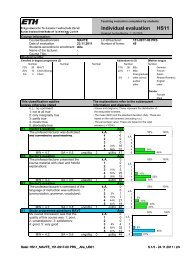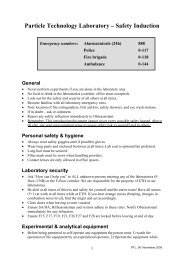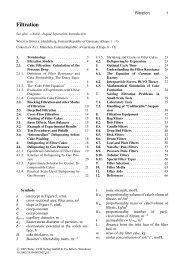Nanoparticles in Lithium-Ion Batteries - PTL
Nanoparticles in Lithium-Ion Batteries - PTL
Nanoparticles in Lithium-Ion Batteries - PTL
Create successful ePaper yourself
Turn your PDF publications into a flip-book with our unique Google optimized e-Paper software.
<strong>Nanoparticles</strong> <strong>in</strong> <strong>Lithium</strong>-<strong>Ion</strong> <strong>Batteries</strong> –<br />
Opportunities and Challenges<br />
Timothy Patey<br />
R. Büchel, , S.H. Ng, F. Krumeich, , S.E. Prats<strong>in</strong>is,<br />
P. Novák<br />
Paul Scherrer Institute<br />
Electrochemistry Laboratory<br />
Villigen, Switzerland<br />
Electrochemistry Laboratory – <strong>Batteries</strong>
Outl<strong>in</strong>e<br />
• Electrochemical energy storage and the Li-ion batteries<br />
• <strong>Nanoparticles</strong> for Li-ion <strong>Batteries</strong><br />
• Co-synthesis of LiMn 2 O 4 and carbon black<br />
nanocomposites<br />
• Outlook of research<br />
2/32<br />
Electrochemistry Laboratory – <strong>Batteries</strong>
Electrochemical energy storage <strong>in</strong> the energy economy<br />
1. Static load levell<strong>in</strong>g of renewable energy<br />
Shanghai, Ch<strong>in</strong>a<br />
3/32<br />
Electrochemistry Laboratory – <strong>Batteries</strong>
Electrochemical energy storage <strong>in</strong> the energy economy<br />
1. Static load<strong>in</strong>g levell<strong>in</strong>g of renewable energy<br />
2. Transportation<br />
Both Toyota and Mercedes will release HEVs with Li-ion batteries <strong>in</strong> 2009<br />
4/32<br />
Electrochemistry Laboratory – <strong>Batteries</strong>
Ragone-plot<br />
1’000’000<br />
Specific Power [W/kg]<br />
100’000<br />
10’000<br />
1’000<br />
100<br />
Pb/PbO 2<br />
Electrochemical<br />
Capacitors<br />
10<br />
<strong>Lithium</strong>-<strong>Ion</strong><br />
1<br />
1 10 100 1’000<br />
Specific Energy [Wh/kg]<br />
5/32<br />
Electrochemistry Laboratory – <strong>Batteries</strong>
Electrochemistry<br />
4 V<br />
LiCoO 2 ,<br />
LiNiO 2 ,<br />
mixed<br />
LiMn 2 O 4<br />
Graphite<br />
Hard Carbons<br />
LiFePO 4<br />
6/32<br />
Electrochemistry Laboratory – <strong>Batteries</strong>
Why nanoscale?<br />
more surface area = <strong>in</strong>crease <strong>in</strong> power<br />
><br />
Why not nanoscale?<br />
more surface area = <strong>in</strong>crease <strong>in</strong> side reactions<br />
><br />
7/32<br />
Electrochemistry Laboratory – <strong>Batteries</strong>
Co-synthesis of LiMn 2 O 4 and carbon black<br />
8/32<br />
Electrochemistry Laboratory – <strong>Batteries</strong>
Preparation of electrodes<br />
Mix contents <strong>in</strong><br />
polar solution<br />
[7:2:1]<br />
Flame-made<br />
powder<br />
+<br />
Carbon black<br />
+<br />
1<br />
B<strong>in</strong>der<br />
Composite<br />
electrode<br />
Assemble <strong>in</strong>to cell<br />
Li anode (-)<br />
Separator<br />
Electrolyte:<br />
LiPF 6 <strong>in</strong> EC/DMC<br />
Composite<br />
electrode (+)<br />
1 - 10% polyv<strong>in</strong>ylidenfluoride (PVDF) 1015 dissolved <strong>in</strong> n-methyl-2-pyrrolidon (NMP)<br />
9/32<br />
Electrochemistry Laboratory – <strong>Batteries</strong>
Cyclic voltammograms – reaction k<strong>in</strong>etics<br />
Specific Current, jm (mA g -1 )<br />
600<br />
400<br />
200<br />
0<br />
-200<br />
-400<br />
Charge<br />
56 % flame-made CB<br />
32 % flame-made CB<br />
0 % flame-made CB<br />
(Li + extraction)<br />
LiMn 2 O Li 1-x Mn 2 O 4 ,<br />
4<br />
Discharge<br />
x 0.7<br />
(Li + <strong>in</strong>sertion)<br />
-600<br />
3 3.2 3.4 3.6 3.8 4 4.2 4.4<br />
Voltage, U (V)<br />
10/32<br />
Electrochemistry Laboratory – <strong>Batteries</strong>
Discharge capacity per unit mass LiMn 2 O 4<br />
Discharge Capacity (Ah kg -1 )<br />
120<br />
100<br />
80<br />
60<br />
40<br />
20<br />
0<br />
0.5C<br />
1C 2C 5C 10C 20C 50C<br />
56 % flame-made CB<br />
32 % flame-made CB<br />
0 % flame-made CB<br />
0 10 20 30 40 50 60 70<br />
Cycle Number<br />
11/32<br />
Electrochemistry Laboratory – <strong>Batteries</strong>
Discharge capacity per unit mass electrode<br />
120<br />
Discharge Capacity (Ah kg -1 )<br />
100<br />
80<br />
60<br />
40<br />
20<br />
0.5C<br />
1C 2C 5C 10C 20C 50C<br />
56 % flame-made CB<br />
32 % flame-made CB<br />
0 % flame-made CB<br />
0<br />
0 10 20 30 40 50 60 70<br />
Cycle Number<br />
12/32<br />
Electrochemistry Laboratory – <strong>Batteries</strong>
Layout of a lithium-ion ion battery – consideration of<br />
nanocomposite (32wt.% carbon black) <strong>in</strong> a battery<br />
LiMn 2 O 4 Electrode / Al Electrolyte C 6 Electrode / Cu<br />
20 m 20 m 10 m 20 m<br />
658 m<br />
159 m<br />
13/32<br />
Electrochemistry Laboratory – <strong>Batteries</strong>
Ragone-Plot<br />
–<br />
LiMn 2 O 4 / CB nanocomposites as hybrid material<br />
1’000’000<br />
Specific Power [W/kg]<br />
100’000<br />
10’000<br />
1’000<br />
100<br />
Pb/PbO 2<br />
Electrochemical<br />
Capacitors<br />
10<br />
<strong>Lithium</strong>-<strong>Ion</strong><br />
1<br />
1 10 100 1’000<br />
Specific Energy [Wh/kg]<br />
14/32<br />
Electrochemistry Laboratory – <strong>Batteries</strong>
Conclusions<br />
• Battery with LiMn 2 O 4 / carbon black nanocomposites<br />
could have a specific energy one order of magnitude<br />
greater than supercapacitators, but…<br />
• Coat<strong>in</strong>g of nanoparticles required to reduce capacity<br />
fad<strong>in</strong>g over the lifetime of the battery (>1000 cycles).<br />
15/32<br />
Electrochemistry Laboratory – <strong>Batteries</strong>
Other activities – past and present<br />
• Synthesis of LiV 3 O 8 cathode material by FSP.<br />
• Electrode optimization of TiO 2 us<strong>in</strong>g surfactants.<br />
• Optimization of LiMn 2 O 4 nanoparticles by FSP.<br />
16/32<br />
Electrochemistry Laboratory – <strong>Batteries</strong>
Other activities – past and present<br />
• Synthesis of LiV 3 O 8 cathode material by FSP.<br />
• Electrode optimization of TiO 2 us<strong>in</strong>g surfactants.<br />
• Optimization of LiMn 2 O 4 nanoparticles by FSP.<br />
Other activities - future<br />
• Advanced electrochemical characterization at the Tokyo<br />
Institute of Technology, Prof. M. Nakayama<br />
• Electrochemical impedance spectroscopy<br />
• Electrochemical calorimetric measurements<br />
17/32<br />
Electrochemistry Laboratory – <strong>Batteries</strong>
Acknowledgments<br />
THANK YOU FOR<br />
YOUR ATTENTION!<br />
18/32<br />
Electrochemistry Laboratory – <strong>Batteries</strong>


